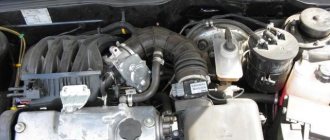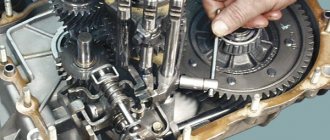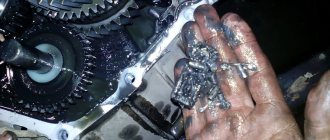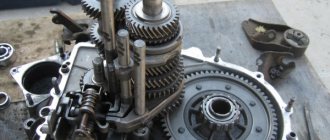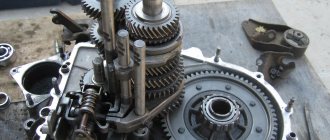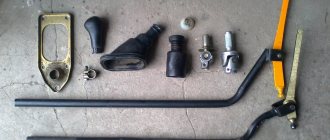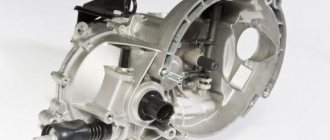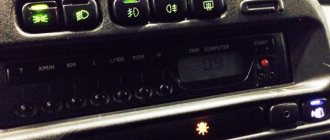The gearbox in a car (hereinafter referred to as the gearbox) is designed to change and transform due to the influence (switching) of the engine gear ratio. It allows you to change the rate of acceleration, increase speed characteristics at different speeds and makes the wheels rotate at different speeds. Sometimes every driver, when operating a car, is faced with the issue of servicing or repairing a gearbox on a VAZ 2114. Some began to notice problems in this unit, others are interested in its uninterrupted and long service, since this element is one of the main ones in the overall structure of the car.
VAZ 2114 gearbox device
Box removal process
Removing the VAZ 2114 box is quite simple, although there are some peculiarities, so it is still advisable to have an experienced partner next to you for the first time.
Tools
- a set of keys;
- Screwdriver Set;
- WD-40 fluid in case you can’t unscrew some part;
Rust converter WD-40
container for draining old transmission oil; new oil (if the replacement was carried out a long time ago); rags; board.
Gearbox VAZ 2114 disassembled
Stages
Since you will have to work under the car, it is better to place the VAZ 2114 car on a pit or overpass; a car lift would be a good solution, otherwise you will have to resort to jacks.
First you need to remove the terminals and remove the battery. Drain the oil from the gearbox into a prepared container by unscrewing the drain plug. We remove the starter. Remove the clutch cable. We disconnect the block with wires from the speed sensor, after compressing the spring. We unscrew the bolt attaching the ignition bracket to the gearbox. Then unscrew the remaining bolts. Under the car we find and disconnect the block of wires leading to the reverse sensor. Unscrew the bolts securing the linkage bracket to the gearbox. Having first loosened the gear shift rod clamp, we pull it out, pushing it back. Dismantling the wheel drives
You can leave the right one. In order for the gearbox to be removed without any complications, unscrew the bolts with which the left ball joint is attached to the steering knuckle. We disconnect the lower mount of the gearbox to the engine - sometimes you can get by by simply loosening the tightening of the bracket. After unscrewing the bolts, remove the transmission housing cover. Unscrew the bolt on the left of the gearbox. We carefully and carefully hang the engine using a board or other device. At the bottom of the car, unscrew the nut securing the left motor mount. We unscrew the two nuts with which the rear motor mount is attached to the body. We unscrew the two bolts with which the rear engine support is attached to the transmission (the second key is used to keep the nuts from turning), and remove the support. We move the box along the guides. This completes the process of removing the box; after completing all the necessary tasks, assembly occurs in the reverse order. When you put the box in place, do not forget to adjust the clutch and fill it with new oil.
Latest comments:
- Igor: I don’t have a fitting, the throttle is electronic, what should I do?
- Denis: Hello everyone. On the ventilators, what should the wires be attached to?
- Vova: I did everything as in the picture, except I didn’t install a new cigarette lighter.
- Mukhtar: Guys, salamaleikum to everyone, I have this problem: arrows on the panel and I have
- Vitaly: Hello, I have a VAZ 2115. I recently encountered the following problem:
Conclusion
The gearbox synchronizer is a mechanism that no modern car with a manual transmission or automatic transmission can do without. Without it, the unit would not only work noisily, but would wear out even faster. In addition, manipulating the gear shift would be somewhat more difficult. Although synchronizers have an impressive service life, sometimes they fail. Accelerated wear of mechanisms is associated with ignoring the oil change regulations, aggressive driving and frequent alternation of fast driving and stopping followed by a sharp start. Fortunately, today you can buy both a new synchronizer and its individual components. Although many craftsmen do not recommend repairing this part, in fact it is repairable. We still suggest that car enthusiasts buy a new synchronizer rather than try to “revive” the old one.
vote
Article rating
Dismantling
To dismantle the box, we recommend that you rely on the instructions, strictly follow the sequence and reinforce your skills with visual videos.
- Disconnect the negative terminal from the battery and drain the oil from the gearbox system.
- Unscrew the bolts that hold the crankcase guard in place and remove it.
- Disconnect the ground (wire) from the clutch housing.
- At the end of the clutch cable, loosen the tension on the nuts slightly.
- Remove the cable end from the clutch lever.
- Disconnect the block from the traction relay.
- Disconnect the wire going to the starter traction relay.
- Dismantle the starter itself directly.
- Disconnect the drive rod from the joint tip. We are talking about traction, which switches gears.
- Disconnect the cable from the car's speedometer drive.
- Unscrew the tie rod ball joint.
- Remove and press the steering rod hinge pin out of the strut swing arm.
- The shank of the inner CV joint of the front wheel drive should be pressed out and moved to the side.
- Disconnect the second CV joint.
- Remove the clutch housing shield.
- Release the gearbox from the fasteners holding it to the engine.
- Remove the box.
Carefully remove the gearbox
Be sure to move it horizontally away from the engine before directly removing the gearbox. Then disengage the input shaft. Be careful not to damage the clutch spring petals.
CLUTCH
The clutch of VAZ 2114, 2113, 2115 has a common structure. The clutch is a device located between the power unit and the wheels of the vehicle. This device takes over the engine speed. On VAZs 2114,2115,2114, the clutch is closed, dry, single-disk, with a damper installed on the driven disk and a pressure spring. The clutch is equipped with a cable drive that has no gap between the pressure spring and the bearing. The control is carried out by a pedal, which is installed together with the brake pedal on the same axis.
With a working clutch, the pedal travel from its top position, and “all the way”, is exactly one hundred and thirty-five millimeters. The pedal stroke, over time, during operation, can increase to one hundred and sixty millimeters, this is caused by wear of the driven disk linings. This increase in pedal travel is considered the maximum permissible; any increase in this gap will lead to the clutch starting to “lead”. This will be caused by an almost complete lack of contact between the slave and master disks. To eliminate this problem, you will need to adjust the clutch.
Clutch device
Malfunctions and their elimination
Gearbox repair largely depends on the nature and type of fault. There are several options for the breakdown of this unit, in each of which appropriate actions should be taken to eliminate them.
Malfunction
Possible reasons
What do we have to do
There is noise in the gearbox
- The teeth on the gears are worn out;
- Bearings are worn out;
- The oil level in the gearbox has decreased
- Add oil;
- Replace worn bearings;
- Replace seals if necessary
Gears are difficult to shift
- The clutch is not fully depressed;
- The rod that controls the gear shift mechanism has become deformed;
- The integrity of the jet thrust has been compromised;
- The joint or rod that selects the gear is loose;
- The speed change drive is incorrectly adjusted;
- The plastic components of the gear shift drive are broken
- Try straightening the rods. If this is not possible, replace them;
- Tighten the mounting screws more tightly;
- Adjust the gear shift drive;
- Replace damaged components
Spontaneous gear disengagement occurs
- The ends of the synchronizer teeth on the gear and clutch are damaged or worn;
- Cracks appeared, the rubber on the rear supports delaminated;
- The gear shift drive was adjusted incorrectly;
- The traction guard was not tightened correctly, which is why the gear is not engaged completely
- Replace worn, deformed elements;
- Correct the position of the rod casing;
- Adjust the drive
Gears are switched on with noise and crackling
- The clutch does not disengage completely;
- The locking ring of the gear synchronizer, which is engaged, is worn out
There is an oil leak from the gearbox
- Wear of the input shaft oil seal; Wear of the rod
- speed selection;
- Breakage of the speedometer drive shaft seal;
- The cover on the gearbox or crankcase is loose;
- The sealant under the gearbox cover is damaged;
- The drain hole closure is loose
- Replace gaskets, use new sealant and gaskets;
- Tighten all existing fasteners;
- Check the condition of the drain plug
In most cases, problems with the gearbox are eliminated by dismantling and disassembling it. Do not take on this type of work without the proper skills and experience.
Disassembly
Having removed the gearbox, you can proceed directly to the main thing - disassembly. This will allow you to change damaged elements as you work, identify existing faults and solve problems on your own.
- Clean and thoroughly wash all external surfaces of the gearbox.
- Place the box in a vertical position and remove the back cover.
- Remove the clutch cable bracket, then use a rubber hammer to knock the rear cover off the gearbox.
- Remove the old gasket. She will be replaced.
- Engage any of the two gears - 3 or 4.
- Unscrew the bolt that holds 5th gear, then turn it on.
- Simultaneously turning on the indicated speeds will allow you to fix the shaft and prevent it from turning.
- Unscrew the nut on the secondary shaft, and then on the primary one.
- Remove the 5th speed synchronizer along with the fork.
- Remove the fork from the coupling. Remove the synchronizer as carefully as possible. If you allow the clutch to move away from the hub, the spring-loaded balls that secure the synchronizer will simply fall apart.
- Remove the 5th speed synchronizer locking ring.
- Remove the 5th speed driven gear from the output shaft.
- Remove the thrust ring located on the needle bearing.
- Remove the needle bearing itself from the 5th speed gear.
- Remove the drive gear from the drive shaft and remove the bearing plate.
- Now the needle bearing bushings should be removed from the secondary shaft, and the thrust washer should also be removed.
Jewelry work
- Take out the ring that secures the input shaft bearing, and then a similar ring for the secondary shaft.
- Unscrew the locking plug and remove the ball and locking spring. Next you can get a couple more clamps.
- Remove the rear engine mount.
- Unscrew the reverse gear lock plug, tilt the box and thus remove the lock ball and spring.
- Remove the clutch housing and gearbox housing mounting bolts.
- Acting as carefully as possible, separate the two units. To do this, there are grooves in the crankcases into which the ends of a screwdriver are inserted. By shaking, you can disconnect the elements without any problems.
- Remove the gearbox housing.
- Unscrew the bolt securing the 1st and 2nd speed shift fork.
- Remove the fork and stem.
- Unscrew the bolt securing the 3rd and 4th speed forks.
- Separate the rod head from engagement with the lever, remove it along with the fork from your gearbox.
When disassembling the box into parts, be sure to pay attention to the condition of the elements. If you detect faults in time and replace gearbox components, you can get by with inexpensive but very effective self-repair
Disassembled gearbox
What to pay attention to
So, following the instructions, we disassemble the gearbox of your VAZ 2109
Along the way, we pay attention to the following points:
- Bearings. When they wear out, a noise from the box occurs. Plus, worn bearings negatively affect the condition of other gearbox elements;
- Synchronizers and sealing washers. If their condition leaves much to be desired, then the gears shifted poorly precisely because of them. Replace them;
- Clutch system, cotters, coupling hub clamps. All this must be replaced separately if there are signs of wear or defects;
- Blocking rings, synchronizers. If there are chips or nicks, don’t even think about alternative solutions, replace them immediately;
- Bearing tracks. Over time they wear out. If signs of wear are found, perform a complete replacement. In this state, they were only a short time away from breaking;
- Gap between gears and locking rings. Normally it is no less than 0.6 mm. In case of deviations, there is only one solution - replacing the rings;
- Retaining rings. If elasticity is lost, these elements must be changed, since they will no longer be able to perform their functions.
When assembling the gearbox, do not forget to lubricate the new gaskets with a layer of lithol. And when pressing the oil seals, do it with the working edge inward. The metal clip should be located on the outside.
https://youtube.com/watch?v=cgCFhYP17
During the process of reassembling the gearbox, all rubbing components should be treated with oil, and do not forget about the sealant for connecting the clutch housings and gearbox. Doing everything yourself is quite possible.
Gear shift mechanism
The gearshift mechanism is usually mounted in gearbox covers and is used to select, engage, and disengage gears. In addition, devices are installed in the gear shift mechanism that prevent the inclusion of two gears at the same time and prevent spontaneous gear shifting.
The main requirements for this mechanism are ease and simplicity of gearbox control, noiseless and smooth gear shifting, reliable locking of the engaged gear, prevention of simultaneous engagement of two or more gears, as well as protection from engaging a gear opposite to the vehicle's movement while moving. In addition, the activation mechanism must be reliable, durable, not requiring complex adjustments and easy to maintain. Malfunctions of the gear shift mechanism can lead to damage to parts and failure of such an expensive unit as a gearbox.
***
The gearbox shift mechanism of a truck (Fig. 1, a) consists of three rods, three forks, three clamps with balls, a fuse for engaging first gear and reverse gear and a locking device. Rods 8, 9, 11 are located in the holes of the internal bosses of the crankcase cover 1. Forks 5, 7, 10 are attached to them, connected to the synchronizer carriages and to the movable gear wheel for engaging first gear and reverse gear.
Clamps 4 hold the rods in the neutral or engaged position, which prevents spontaneous gear disengagement. Each retainer is a ball with a spring installed above the rods in special sockets in the crankcase cover. The rods for the clamp balls have special grooves (holes). Moving the rod with the fork, and therefore the synchronizer, is only possible when force is applied by the driver, as a result of which the ball sinks into its seat.
The locking device prevents two gears from being engaged simultaneously. It consists of a pin 12 and two pairs of balls 6 located between the rods in a special horizontal channel of the crankcase cover. When any rod moves, the other two are locked with balls that fit into the corresponding grooves on the slides.
In order to prevent accidental engagement of reverse gear or first gear when the vehicle is moving, a fuse is mounted in the wall of the gearbox cover, consisting of a bushing, a ring with a spring 3 and a stop. To engage first gear or reverse gear, it is necessary to press the fuse spring all the way, for which some force is applied to the driver control lever.
***
The gear shift mechanism of a passenger car (Fig. 1, b) is arranged as follows. Rod 14 of the third and fourth gear shift fork is installed in the holes of the front and rear walls of the crankcase, and rods 13 and 16 are installed in the holes of the rear wall and crankcase boss.
The 15, 21, 23 gear shift forks are secured with a bolt on each rod. To hold the rods in the neutral position and in one of the extreme positions when the gear is engaged, they have three sockets, to which the retainer ball 20 is pressed by a spring 19. The clamps are located in bushings and are closed with a cover 18. In the head of each rod there is a groove into which the lower end of the gear shift lever fits.
The locking device consists of three locking blocks 17. The two outer blocks are installed in the holes of the rear wall of the crankcase, and the middle block is in the hole of the rod 14. When the rod 13 or 16 moves, it squeezes out a block that fits into the socket of the middle rod and at the same time presses the other through the middle block cracker to the socket of the opposite rod. This way, these rods will be locked in the neutral position. When moving the middle rod 14, two crackers are squeezed out at once and the outer rods 13 and 16 are fixed.
***
Academic disciplines
- Engineering graphics
- MDK.01.01. "Car design"
- General structure of the car
- car engine
- Car transmission
- Steering
- Brake system
- Suspension
- Wheels
- Body
- Car electrical equipment
- Basic car theory
- Basics of technical diagnostics
- Fundamentals of hydraulics and heat engineering
- Metrology and standardization
- Agreecultural machines. Agreecultural equipment
- Basics of agronomy
- Transportation of dangerous goods
- Materials Science
- Management
- Technical mechanics
- Tips for graduate student
Olympics and tests
- "Engineering graphics"
- "Technical Mechanics"
- "Engine and its systems"
- "Car chassis"
- "Car electrical equipment"
Main couple
The main pair is the main shaft (main gear). The main pair serves to reduce the speed transmitted from the engine. On average, the main pair reduces the number of revolutions by 4 times: the engine spins 4 thousand revolutions - the main pair 1 thousand revolutions. The main pair as standard has a gear ratio: 3.7. By changing the main pair, you can significantly change the dynamics of the car. Depending on the size of the main pair, you can change the length of all gears, hence the maximum speed and acceleration. (By the way, the “nine” has a 3.9 main pair, due to this it has a lower maximum speed, but is faster at acceleration).
Below are three graphs by which you can compare the speed at 5500 rpm of an engine with different main pairs. (Calculations are based on r15 wheels with a 195/50 profile - the same as r14 with a standard VAZ profile 175/65 or 180/60).
Gear selection mechanism VAZ 2109 repair
This is interesting
Downloads 1998Average speed 4351 Kb/s
Download
https://youtube.com/watch?v=h4wwwSsCNDk
To perform repairs associated with the dismantling and subsequent replacement of the mechanism, prepare a standard set of tools and perform the following sequence of actions:
After removing the decorative tunnel located between the front seats, remove the gear shift mechanism. The mechanism must be replaced if there are signs of wear, distortions, loose bushings and other defects.
Varieties of backstage
Despite the different design models, only two types can be distinguished:
- Long-stroke (standard, previously installed on cars of model 2109 and similar).
- Short-wheel drive (installed on Kalina cars).
Structurally they are very similar, only different in size. The advantage of short-throw ones is that with their help, gears are engaged easier and faster.
True, many myths have formed around the gear shift: some claim that the dynamic characteristics of the car are significantly improved. This is all wrong; there is no connection between the dynamics of the car and the view of the backstage. But still, the short-stroke one has advantages over the standard one.
How the box works
It has features that entirely depend on the configuration of the machine. This could be a four- or five-stage vase model. The structure of a four-speed gearbox is as follows:
- 1. Primary shaft;
- 2. Reverse gears, to which the front shaft is attached;
- 3. Synchronizers, 2 pieces;
- 4. Bearings placed on the secondary shaft;
- 5. Driven gear. Attached to the differential flange.
The element is controlled by a drive, rod, rod and ball joint. Only complete interaction of these parts can ensure full operation of the box.
Gearbox device
To determine the type of gear, there is an additional lever, which is attached to the inner end of the rod.
There are also axles in the body; a three-arm lever is attached to one of them. Its main purpose is to lock the bracket and bushing, which is necessary to ensure the strength and immobility of the mechanism.
The second axis is designed to fix the locking brackets from their rotation, passing through the center. In addition, there is a lock that prevents the box from loosening. The other axle also has a fork, which is necessary to engage the VAZ 2114 in reverse.
The five-stage type differs in the size of the shaft and the absence of a bushing in the element. Usually this is what is installed in the VAZ 2114, since the other one is not entirely practical to use. Like any spare part, a gearbox can also break down and fail.
The most common problems are:
Unknown noise: it may be caused by bearing failure or gear wear. In addition, you should play it safe and check the oil level;
The solution to the problem is to completely replace failed spare parts and add oil.
Difficulty shifting the VAZ 2115 gearbox: the drive rod may have become deformed. It would be a good idea to check how firmly all the screws are screwed on and how the box drive is adjusted correctly. There is a possibility of failure of plastic parts in the drive;
Solution: Strengthen the screws, adjust the drive, replace worn and failed parts, replace or correct the deformation of the rod.
Turning off the gearbox without the driver's participation: the cause may be damage to the teeth on the synchronizer, an incorrectly adjusted drive, or poor installation of the traction cover, which provokes incomplete engagement of the traction;
Solution: Adjust the drive and replace the covers, replace the failed spare parts.
Oil leak. The reason is still the same - wear of spare parts, which this time are oil seals, seals and hinge bodies
In addition, you need to pay attention to the strength of the fastening. If it becomes loose, it is necessary to tighten all the bolts and check the seals for damage;
Solution: Purchase new spare parts and replace them.
Where and how is it more profitable to buy a gearbox in case of its complete failure? Since the performance of the vehicle and safety depend on the VAZ 2114 gearbox, its technical condition must be taken very seriously.
That is why it is worth recalling that, like any element of the machine, the gearbox needs regular technical inspection. Saving on oil changes, untimely detection and replacement of breakdowns, complete ignorance of troubles with the machine’s mechanisms - all this leads to failure of the gearbox.
Don’t think that if you have a domestic car, that means you are lucky. The rise in prices for spare parts is indicated by the price of the box, which today ranges from 16 thousand rubles. up to 18 thousand rubles Add in fees for removal, installation and maintenance - the cost will be impressive.
Used manual transmission for Lada 2114
An easier option would be to purchase a used item. No one will give a guarantee that there are no defects in it, but the purchase will cost half as much.
The best option is to carry out timely maintenance and repair of the box. This approach will not only save the budget, but will extend the life of the parts.
ALL ABOUT CAT
Diagram, device of the VAZ 2110 gearbox. Replacing the airbag, signs of malfunction
Models VAZ 2113, 2114, 2115 are equipped with a five-speed manual transmission.
"COMPOSITION" of the checkpoint
In general, the gearbox on a VAZ consists of two blocks: the housing (it includes the clutch housing and gearbox, as well as the rear cover), and the internal part (gear ratios, differential and main pair).
Let's look at the internal structure of the gearbox. The main pair is the main gear (also called the main shaft of the box). It serves to reduce the speed transmitted by the power unit. The average “performance” of the shaft is a fourfold reduction in the number of revolutions. For example, with a torque of the power unit of four thousand revolutions per minute, the main pair “produces” only one thousand revolutions, respectively.
Another important component of the internal structure of a transmission is the gear ratios. Gear ratios are gears, each of which is responsible for its “own” gear. Cars produced in Tolyatti usually have the following gear ratio parameters:
- 1st: 3.636
- 2nd: 1.95
- 3rd: 1.357
- 4th: 0.941
- 5th: 0.784
- Reverse: 3.53
The main part of the VAZ 2114 gearbox is the rocker (the part is used when changing gears).
Backstage
Developed in the 80s of the last century, the rocker has many drawbacks, including poor “interactivity” when changing gears (gears may not engage the first time, constantly jam, or engage poorly). The speed of gear shifting depends on the length of the link. Typically, sports cars are equipped with a shortened version of the rocker, this allows you to solve many problems with gear shifting and add dynamics to the car. Well, to improve the “controllability” of gears, another part of a similar purpose has long been used: a cable. Thanks to it, you can clearly and quite easily switch to the desired gear.
DISADVANTAGES OF GEARBOX VAZ 2114,2113,2115
In VAZ 2114 cars, there is a loss of dynamics when switching from 1st to 2nd gear. This is due to the fact that the 1st is quite long, but the 2nd, exactly the opposite, is too short. In addition, with frequent sharp gear changes, the 2nd gear synchronizer may fail. Tuned and sports cars VAZ “13,14,15th” series can boast of excellent dynamics. This is due to the fact that the “gap” between “1st” and “2nd” gears is reduced to a minimum.
The drawstring is too long. Because of this, gear shift speed suffers. In addition, the imperfection of the rocker design makes the process of switching gears quite complex and ineffective.
Gear shift diagram for VAZ 2114
Basin - lurkmore.
Repair of VAZ backstage. Repair of VAZ-2109 gearbox.
Buy a gearbox in Novosibirsk.
Repair, disassembly and troubleshooting of gearbox parts. Correct gear shifting, gear shifting, how.
The battery light is on on the dashboard of the VAZ-2114.
Diagram under the hood of a VAZ 2114 (solved) - 1 answer.
Universal gear shift youtube. VAZ backstage (gear shift lever).
Gearbox VAZ-2114: design, operation, maintenance and repair.
Replacing the ball joint VAZ 2108-2115: photos and videos.
Changing the oil in the VAZ 2108 gearbox.
How to diagnose and repair a VAZ-2114 gearbox?
Checkpoint How to properly disassemble and reassemble the gearbox? VAZ.
Gear shift mechanism of VAZ 2110 (photo). Buy VAZ (Lada): official dealer of Lada car showroom.
Speech monitor for gearbox and handbrake for VAZ-2114 Samara. Repair of gearbox VAZ 08 to 15.
Gearbox gear shift diagram Lada forum.
Extending service life
- Follow the sequence of speed changes and make all shifts smoothly, without jerking.
- When switching between first and second gear, maintain short one-second pauses.
- A preventive examination will help detect and eliminate defects.
- To maintain the functionality of the fifth gear, it is recommended to fill the gearbox oil above the maximum mark. To prevent leaks (air locks), oil is poured in 100 ml portions. Sometimes another oil seal is added to the rocker to prevent leaks.
- The gearbox oil 2114 should be changed after 60-80 thousand kilometers.
Diagnostics and minor repairs of the device
The gearbox, like many car components, sometimes malfunctions and requires maintenance. There are several main reasons that lead to problems. If you hear extraneous noise in a VAZ gearbox, it may be due to wear on the gear teeth or bearings. The box may make noise if the oil level is low. To solve the problem, it is necessary to replace worn mechanisms, oil seals and bring the oil level to normal.
Problems when shifting gears. In this case, it is necessary to inspect the control drive rods for wear. You should check the reliability of the hinge mounting and the gearbox lever rod. Incorrect debugging of the switching drive or breakdown of plastic parts of the assembly can also cause a similar problem. To troubleshoot problems, you need to adjust or replace the rod, tighten the screws and adjust the drive, and replace faulty parts.
- Unplug the box.
- Drain the oil and disconnect the starter.
- Remove the crankcase protection.
- Disconnect the fastening cable and remove it from the bracket.
- Remove the wires by pressing the spring.
- Remove the reverse control wires.
- Unhook the rod from the hinges, moving it back a little.
- Remove the clutch cover.
- Hold the box and unscrew the remaining nuts.
Gear ratios (row)
These are the gears of each gear, which also have their own size.
They characterize the speed of the car in one gear or another. The standard VAZ uses the following numbers:
Above are the specifications with standard parameters.
The standard series on 2114 is far from ideal. The first gear is too short, the second is too long. Due to this, there is a sharp drop in dynamics when switching from first to second. Not only is there a failure, but when switching sharply, the second speed synchronizer slowly dies.
Therefore, there are sports series where the gap between 1st and 2nd is removed, and not only: sports series are selected according to the type of engine. It could just be a good city engine, or a sports engine, or tailored for 402-meter racing. There are also “turbo” gears designed for a turbo engine.
What are synchronizers made of?
Most often, synchronizers are made of brass or steel. Metal rings are formed either by forging or using a powerful press. In this case, the gear rims can be coated with a protective coating of molybdenum, iron, and copper. In modern gearboxes there are synchronizers covered with a layer of carbon fiber. The purpose of the coating is to reduce noise and provide high friction when in contact with the gear. Carbon coated rings offer excellent performance, but are quite expensive to produce, so such parts are only found in the transmissions of high-end sports cars.

